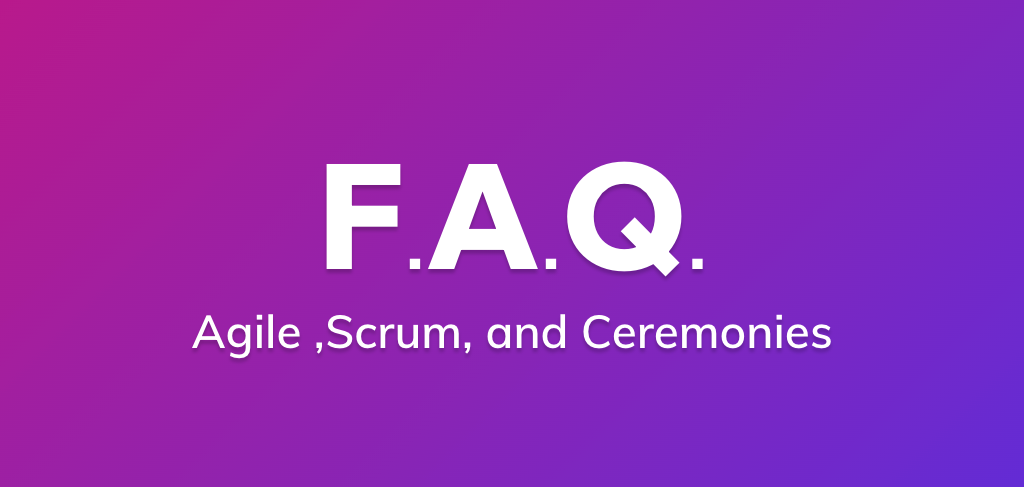
Your FAQ about Agile, Now Answered!

What is an agile ceremony? What is a Scrum Master? What are some common challenges with agile ceremonies? These are some common questions about what Team O'clock offers and how that can be translated into your business and your team.
Therefore, this blog sheds light on the basics of agile ceremonies, the best practices, and how to maximize your team's efficiency to grow your business. Let's dive in!
What are agile ceremonies, and why are they essential in agile project management?
Agile ceremonies are regular, structured meetings or events held within agile project management to facilitate collaboration, communication, and progress tracking. These ceremonies are crucial because they promote transparency, alignment, and continuous improvement. They provide opportunities for teams to plan, review, and adapt their work, ensuring that projects stay on track and deliver value to stakeholders.
What are the key differences between the agile ceremonies?
There are four common agile ceremonies, each serving a specific purpose.
Sprint Planning: a session where the team decides what tasks to work on in the upcoming sprint. They review the prioritized list of user stories or tasks, discuss the effort required, and determine how much work they can commit to completing during the sprint. The meeting sets the team's goals and establishes a plan for the sprint's execution.
Daily Standup (Daily Scrum): a brief daily meeting where the team members come together to share updates on their work progress. They stand up to keep the meeting short and focused. Each team member discusses what they did yesterday, what they plan to do today, and any obstacles they face, fostering better communication, coordination, and problem-solving within the team.
Sprint Review: a session held at the end of each sprint where the team showcases their completed work. They demonstrate the new features or improvements to stakeholders and gather feedback. The meeting allows the team to receive valuable input and adjust their priorities for the next sprint based on the stakeholders' input and changing requirements.
Sprint Retrospective: a regular gathering where the team reflects on their recent work. They discuss what went well and what could have been done better and develop action items to improve their future performance and processes. It's a valuable opportunity for continuous learning and team growth.
What are the key roles in agile ceremonies, and what are their responsibilities during these meetings?
Key roles in agile ceremonies typically include:
Scrum Master: The Scrum Master ensures that agile ceremonies are conducted effectively. They facilitate meetings, remove impediments, and help the team adhere to agile principles.
Product Owner: The Product Owner represents the stakeholders and manages the product backlog. They clarify requirements and priorities during ceremonies like Sprint Planning and Sprint Review.
Development Team: The Development Team comprises cross-functional members responsible for delivering the product increment. During ceremonies, they actively participate, share progress, and collaborate on planning and problem-solving.
Responsibilities during agile ceremonies:
Scrum Master: Facilitate the meeting, maintain timeboxing, encourage collaboration, and ensure the team follows the agile framework.
Product Owner: Communicate the vision, clarify requirements, and collaborate with the team to maximize value delivery.
Development Team: Share updates, discuss challenges, plan work, and collectively make decisions to achieve sprint goals.
How long should agile ceremonies typically last, and how frequently should they be held?
The duration and frequency of agile ceremonies may vary depending on the team's size, project complexity, and sprint duration. However, the general guidelines are:
Sprint Planning: 2-4 hours for a two-week sprint.
Daily Standup: 15 minutes for teams working in the same office or time zone. For asynchronous teams, the duration can vary from 4 to 12 hours, depending on team distribution.
Sprint Review: 1-2 hours for a two-week sprint.
Sprint Retrospective: 1-3 hours for synchronous teams and up to a week for a fully remote team.
Can agile ceremonies be conducted in a remote or distributed team setting?
Agile ceremonies can be conducted effectively in remote or distributed team settings. With the help of various collaboration tools like video conferencing, project management software, and virtual whiteboards, teams can still engage in productive discussions and maintain transparency.
To know more about Agile ceremonies in a remote setting, check out the free Remote Scrum Guide e-book.
How can I ensure active participation and engagement during agile ceremonies?
Active participation and engagement during agile ceremonies can be ensured with the following tips:
Set clear expectations: Communicate the importance of participation and explain each ceremony's objectives.
Keep them time-boxed: Stick to the scheduled time to maintain focus and avoid unnecessary delays.
Encourage open communication: Create a safe environment where team members feel comfortable sharing their thoughts and concerns.
Rotate facilitators: Allow different team members to lead the ceremonies to promote ownership and involvement.
What are some effective techniques for facilitating productive and efficient agile ceremonies?
Set the scope: Define the specific time frame and establish discussion limits to help the team narrow their focus.
Visual aids: Use charts, graphs, or virtual boards to illustrate progress and engage in discussions more.
Timeboxing: Set specific time limits for each agenda item to maintain focus and avoid overruns.
Check-ins: Begin each meeting with a brief personal check-in to build rapport and improve team dynamics.
What are some common challenges faced during agile ceremonies?
Time Management: Struggling to keep ceremonies within the designated time can hinder productivity and reduce focus.
Lack of Engagement: Low participation and disengagement from team members can hinder effective communication and collaboration.
Remote Collaboration: Distributed teams may face challenges in coordinating across time zones and using virtual tools effectively.
Overwhelming Backlog: An overly extensive product backlog can make Sprint Planning and other ceremonies inefficient.
Conflicts and Disagreements: Disagreements among team members or stakeholders can disrupt the flow of discussions and decision-making.
Ineffective Retrospectives: Sprint Retrospectives might not yield actionable insights for process improvement.
Stakeholder Involvement: Limited or inconsistent stakeholder engagement during Sprint Reviews can hinder feedback collection.
Incomplete Preparations: Poorly planned ceremonies without clear agendas can lead to unproductive meetings.
Addressing these challenges requires open communication, continuous improvement, and adaptability within the team and organization.
How do I handle conflicts or disagreements that arise during agile ceremonies?
Address privately: If possible, handle conflicts one-on-one outside the ceremony to avoid disruptions.
Encourage open dialogue: If disagreements arise during the meeting, encourage those involved to express their viewpoints respectfully.
Find common ground: Facilitate discussions to identify areas of agreement and work toward a consensus.
Involve the Scrum Master: If conflicts persist, involve the Scrum Master or a neutral party to mediate the situation.
How can I measure the effectiveness and impact of agile ceremonies on project success?
Collect feedback: Regularly seek feedback from team members on the usefulness and efficiency of the ceremonies.
Monitor project progress: Compare the project's performance and delivery rate before and after implementing agile ceremonies.
Assess stakeholder satisfaction: Gather feedback from stakeholders to evaluate if their needs are being met.
Review team morale and collaboration: Gauge the team's satisfaction and cohesion, as agile ceremonies should positively influence these aspects.

More articles to check

Assist your team's growth with our partnership program:








